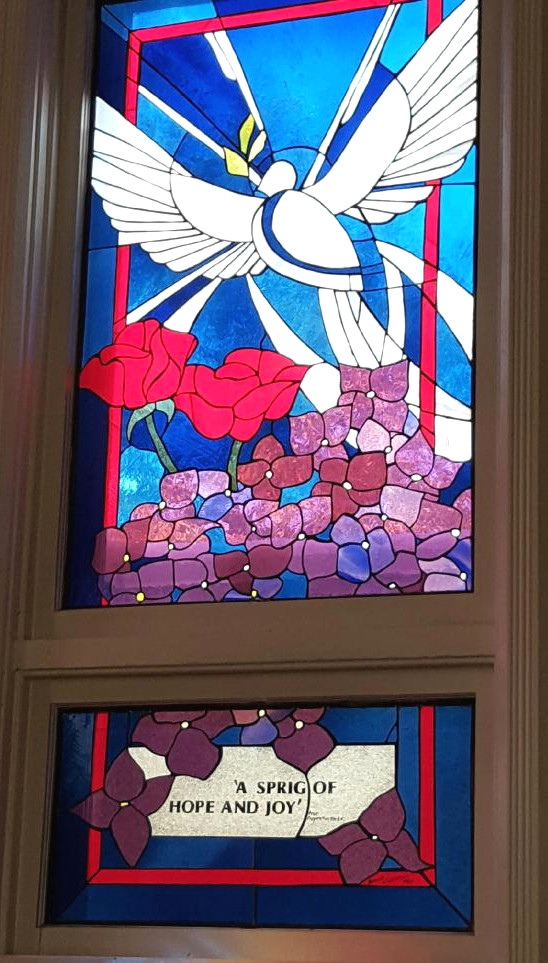Tag: yeg seniors

When Stanley Construction first met with tenants of Knox-Met Manor to describe their plan to replace the windows of the seven-story building – with the seniors still living in their units – tenants thought it would be impossible. How could they live in a construction zone for six months, with no windows, in the middle of the summer? By the time the project wrapped up, the seniors and the construction team were sad to say goodbye to each other. What happened to bring about this happy ending to a challenging project?
Building Lasting Connections
Throughout the project, the Stanley team demonstrated a remarkable commitment to being senior-friendly, and treated the seniors with the utmost respect, ensuring the work did not come before their Quality of Life.
Over time, the workers’ kindness grew on the tenants, and they formed friendships. One tenant (pictured above with a few of the Stanley crew members) would occasionally prepare lunches for the workers, which the workers appreciated.
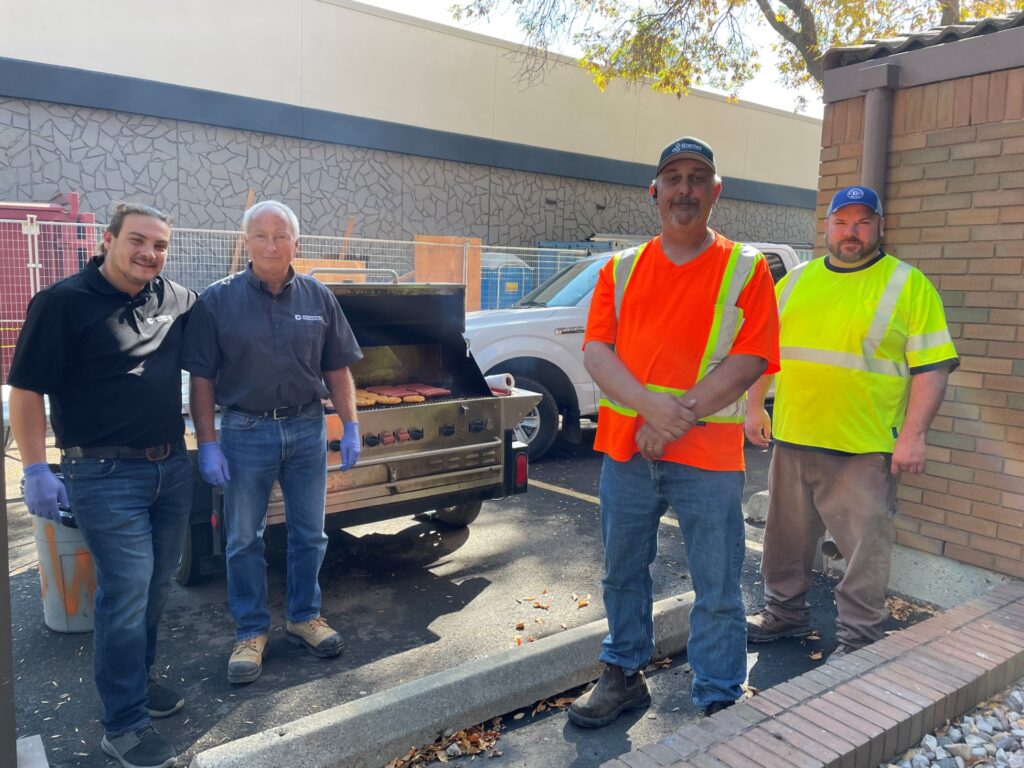
At the September 12 wrap-up BBQ hosted by Stanley with support from Cooper Equipment Rentals, both sides expressed how much they cherished the connections that were formed and how much they will miss one another.
The great new windows were almost a bonus compared to the relationships formed during the construction project!
A Sustainable Upgrade
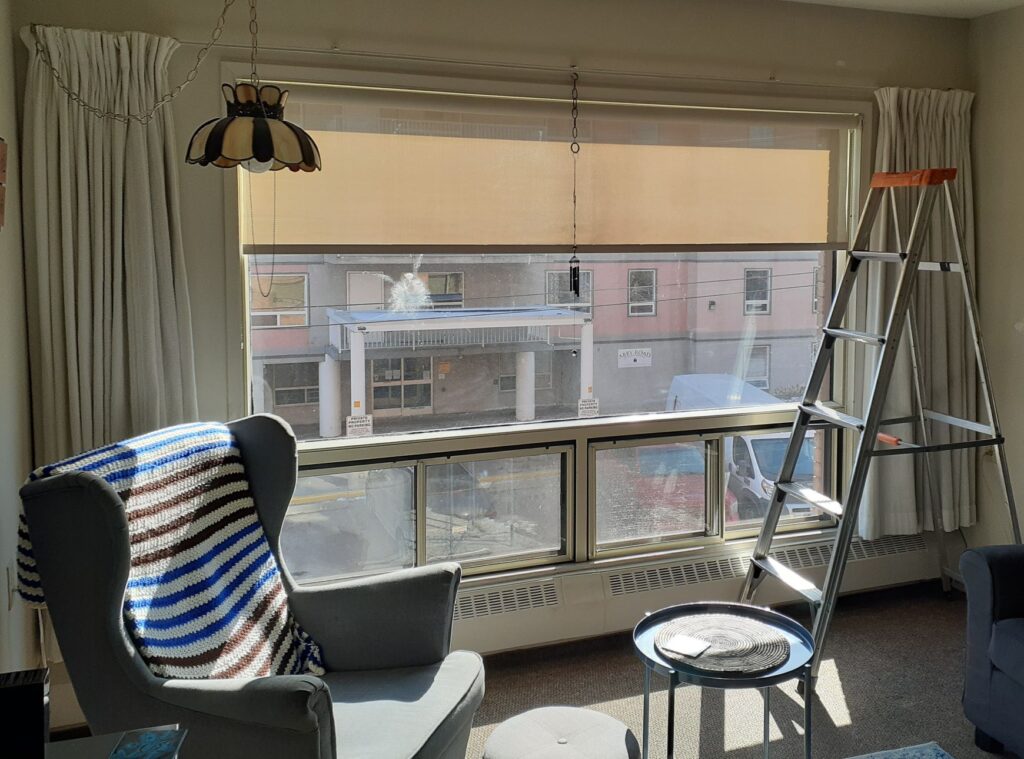
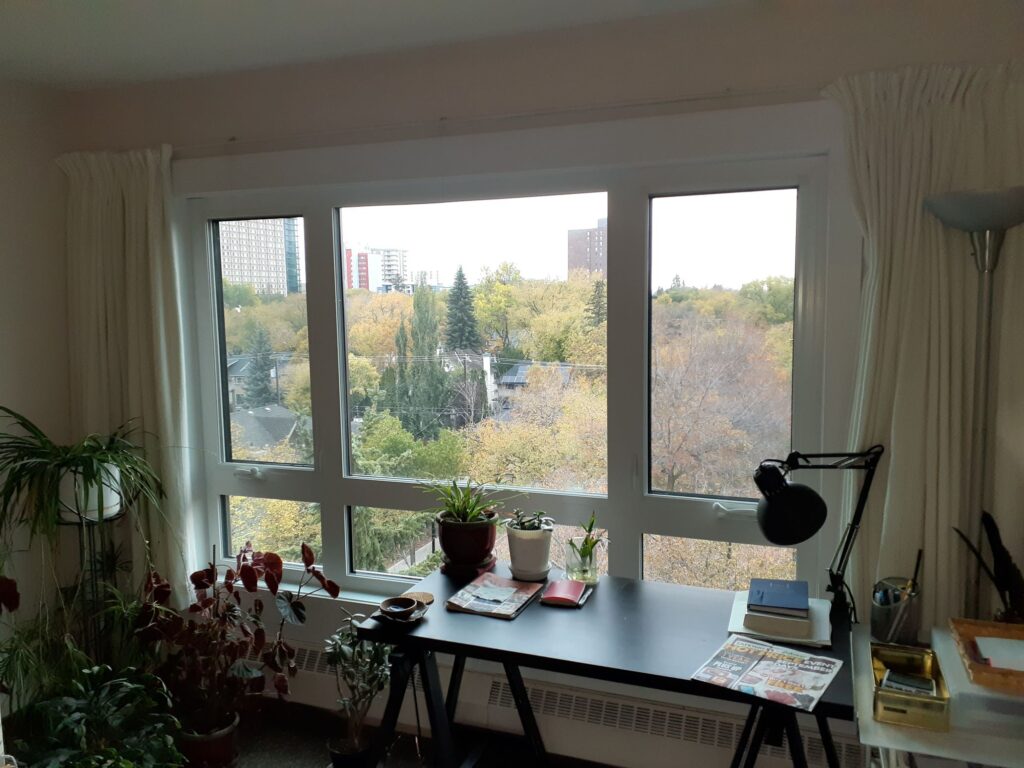
The new windows are triple pane, PVC, casement style windows with a special coating that reflects solar rays, helping to keep the suites cooler in the Summer. In total, 159 suite windows and 18 shared area windows were replaced, contributing to greater energy efficiency.
To further enhance tenant comfort and energy efficiency, GEF made sure to install new roller-type solar shades on all of the suite windows facing south.
Together, We Can Make a Difference
This project exemplifies the kind of partnership we aim to foster between our community partners and the clients we serve. As part of our Quality of Life Philosophy, we promote and encourage relationships between seniors, staff, and communities based on respect, kindness, and compassion.
We invite other vendors and partners to collaborate with us to enrich the lives of seniors and to give back to our community.
Visit our donations page to learn more about our current campaigns and contribute to our Quality of Life fund. Together, we can make a lasting impact on the lives of seniors.
I was a very magical few days in December for hundreds of GEF Seniors Housing residents when Santa and his elves made their rounds to deliver presents as part of London Drugs’ Stocking Stuffers for Seniors 2019 Campaign.
What started out in 2015 with Operation Friendship Seniors Society and London Drugs partnering together with a goal to help 40 seniors in its first year has grown exponentially in five short years. Today, Stocking Stuffers for Seniors helps more than 4,000 seniors in Northern Alberta and 17,000 seniors across Western Canada have a brighter Christmas! The campaign now involves all London Drugs stores. Altogether, 878 seniors in eight different GEF Seniors Housing communities received a gift this holiday season.
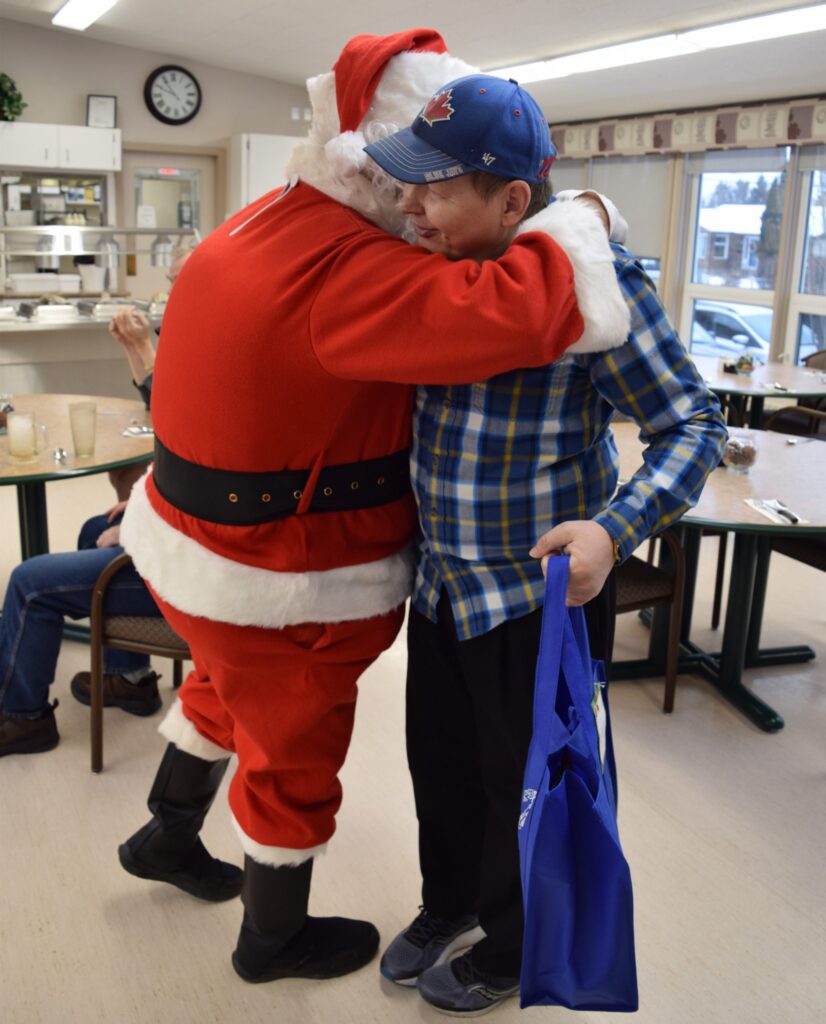
The approach is simple, but the impact is immeasurable. Generous strangers carefully choose a name tag from specially-marked tree displays at their London Drugs store of choice and, our of the goodness of their hearts, but what’s written on the tag as their senior’s wish list – often adding in a few extra surprises. “I think the generosity of others in the community and the surprise of receiving a gift was really awesome,” said Montgomery Place Recreation Coordinator, Christine Kemp.
On delivery day, everyone was buzzing with anticipation. “I was up early – I am so excited!” said one resident. Santa and his London Drugs elves arrived, and the faces of residents and staff lit up like Christmas trees. “It was like Christmas morning for these residents – they were glowing,” said one staff member.
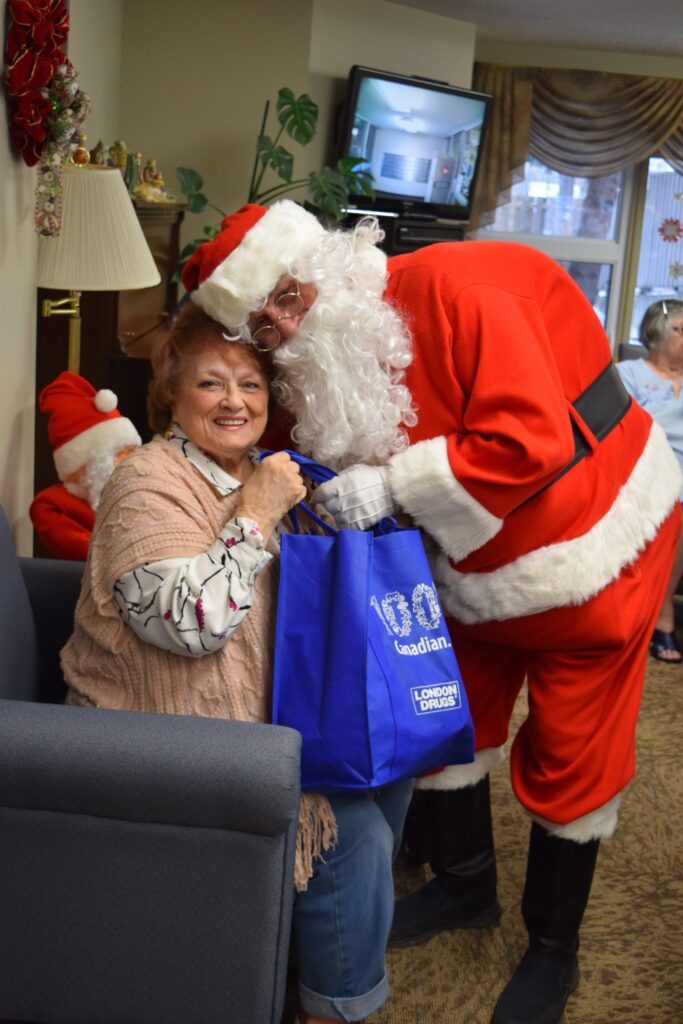
It was an overwhelming sight to see the number of presents that showed up under the trees at our GEF communities. After the gifts were distributed, residents started opening their presents. As well as the chorus of “oohs” and “aahs” around the room, seniors said comments like “This is more than I expected,” “This is over and above anything I could have imagined,” “I got just what I wanted,” “I wish I could say thank you to all the kind people,” and “I don’t usually get excited for Christmas anymore but this brought back feelings that I had as a kid.”

Some of our residents don’t have family so it was a surprise to them when they received a gift. “I wouldn’t have gotten any Christmas gifts this year, so thank you very much,” said one resident. At least one senior saved his presents to open on Christmas day because he doesn’t have any family. These unexpected gifts, filled with love, showed the residents just how much ther are cared for and each senior was grateful for what they had received.
“When you see someone’s face light up and the expression of someone who doesn’t normally get this, it’s a really special feeling and it makes my heart happy!” said another staff member.
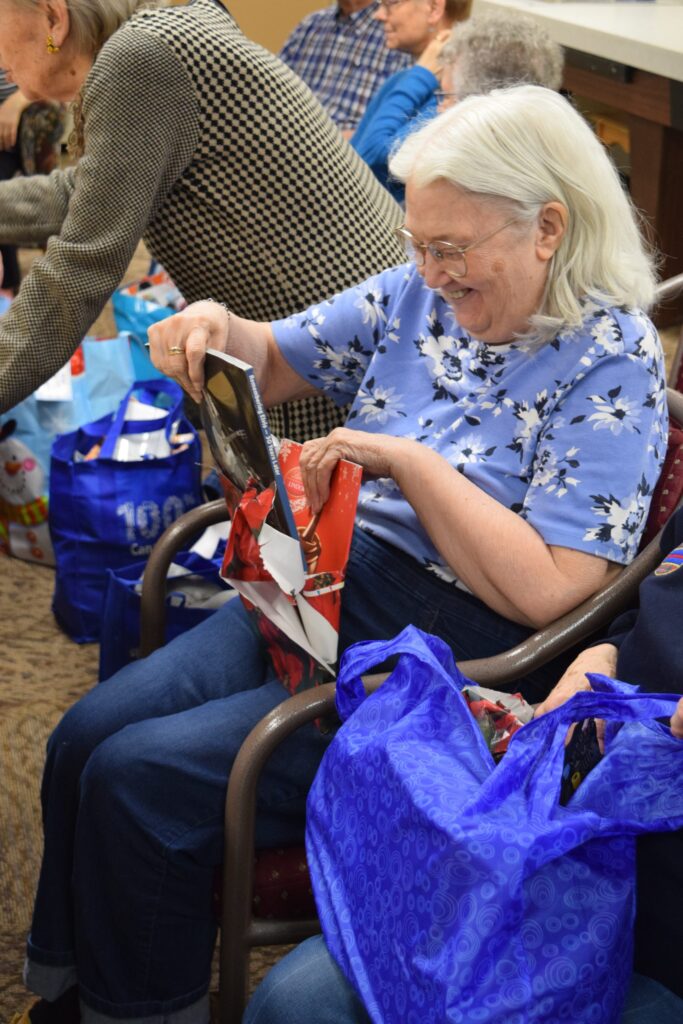
Thank you to everyone who contributed to making this Christmas so memorable – not just for our seniors, but for all of the participating seniors who needed a little cheer this year! It will be a day they will never forget.
On Sunday, December 1, some of our GEF Seniors Housing residents took in the beautiful sights of Zoominescence at the Edmonton Valley Zoo through a different lens – on a Trishaw bicycle.
Zoominescence is a spectacular exhibition of artistic light installations within the Zoo grounds, and GEF partnered with Age-Friendly Edmonton to bring in our own Trishaw, a specialized three-wheel bike piloted by a trained volunteer, that gives older adults the experience of “wind in their hair” without having to drive a bike themselves.

Cycling Without Age Beaumont brought in two additional trishaws and volunteer pilots and made sure all three trishaws were mechanically ready for winter, including installing studded tires.
One attendee, who was chauffeured to the event by our community partners at Drive Happiness, said when she arrived at the zoo that she wasn’t sure what she had signed up for. At the end of the tour, she shared that she had a marvelous time. She hadn’t been back to the Edmonton Valley Zoo since her children were young and told the organizers she was so glad she came out.
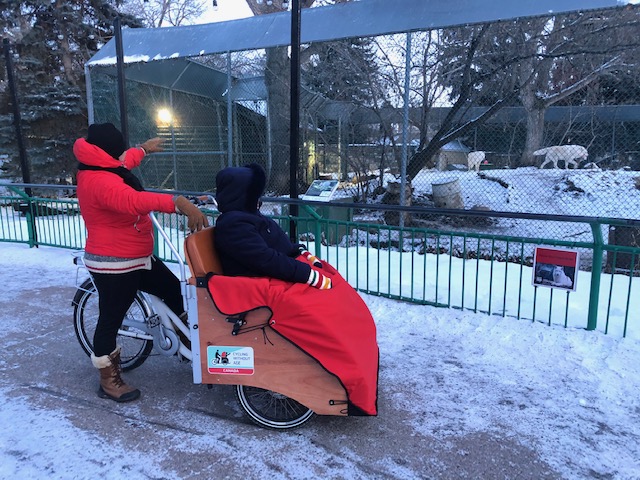
“I’m very grateful that GEF Seniors Housing and its staff support the Cycling Without Age Edmonton program and promoted this opportunity to enrich seniors’ lives,” said GEF Board Vice-Chair Jacquie Eales, who also took the beautiful photos featured in this article.

Are you – or do you know – a senior who would love to take a ride in a Trishaw during Zoominescence 2019? Trishaw rides are only being offered between 4-5 p.m. on December 15 and 22. Spots are very limited, and you can email Jacquie Eales to reserve your ride time at jeales@telus.net.
For more information on Zoominescence itself, including tickets, visit the Eventbrite page. Ticket prices range from $6 – $30. Zoominescence 2019 runs every Friday, Saturday, and Sunday evening in December, from 5-9 p.m., until Sunday, December 29, 2019.
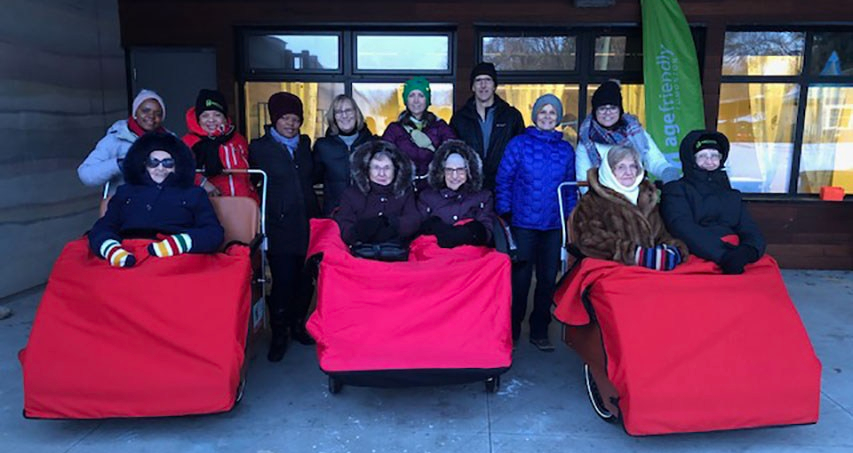
For the past six years, GEF Seniors Housing has taken part in the K-Days Parade festivities. In 2015, GEF Seniors Housing won the best not-for-profit float award. The float saw mascots Harold and Mildred standing next to a small house and waving to the crowds. In 2016, Harold and Mildred went to prom with a float that celebrated the class of 1959 (the year GEF Seniors Housing was established). This year, the K-Days Parade marches through downtown Edmonton starting at 10:00 a.m. on July 21, 2017, and Harold and Mildred are packing up the car and taking a road trip across Canada to celebrate the country’s 150th Anniversary.
“Any chance we get to connect with the communities we operate in, we want to take advantage of it,” says GEF Seniors Housing Public Relations Manager Christopher Schieman. “The K-Days Parade allows thousands of Edmontonians and other Albertans from surrounding areas to see who we are and want to connect with us.”
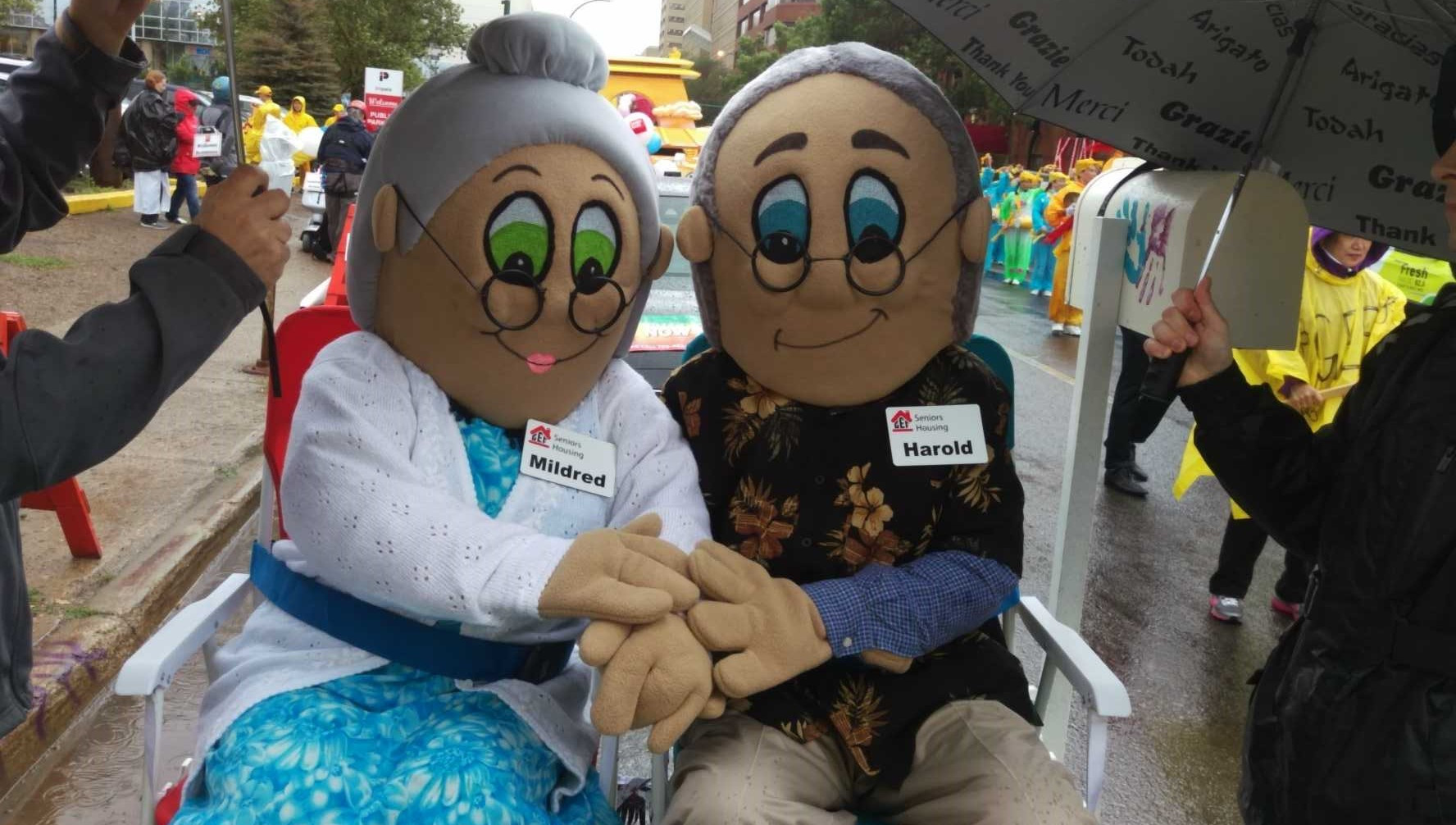
GEF Seniors Housing staff volunteer to put on the mascot costumes and dress up to the parade float’s theme. Schieman remembers the 2016 parade and trying to find leisure suits and retro-style prom dresses for the more than a dozen volunteers who walked alongside the float.
“The Communications team spent a day digging through the racks at Value Village looking for dresses and suits,” Schieman says with a laugh. “We donated everything right back after the parade to make sure that the community members who shop at that Value Village can find more long-term use for the clothing.”
This year, the staff volunteers in the parade will be dressing up in Canadian pride summer clothing to walk alongside the float being built to look like a car surrounded by different Canadian monuments. Schieman points out that each year, the audience members most excited to see the float always surprise him.
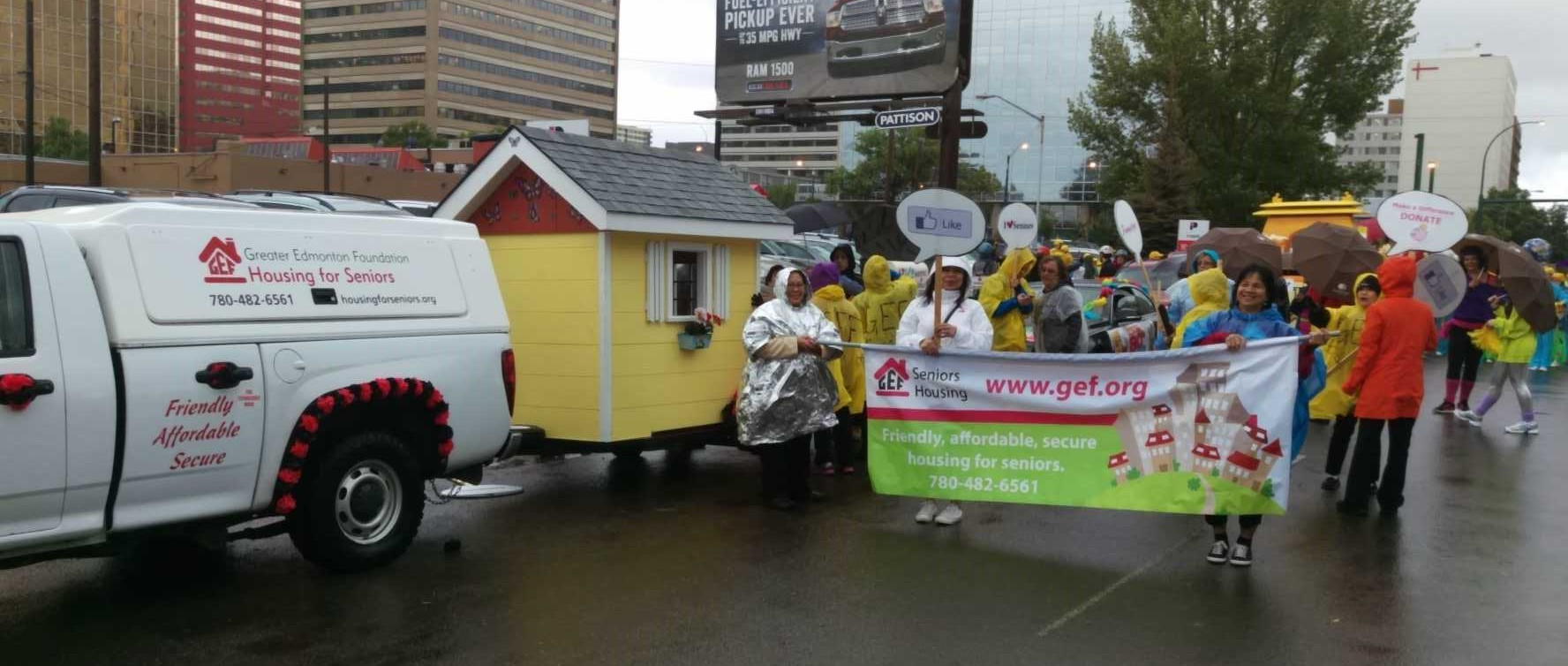
“The kids watching the parade love Harold and Mildred,” says Schieman. “They wave really big and yell, ‘It’s Grandma and Grandpa!’ It’s a nice reminder of how important grandparents are to families and how what we do at GEF Seniors Housing helps so many people.”
Schieman always volunteers to ride shotgun in the truck pulling the float so he can snap a few pictures of the audience for social media as they drive by. He explains it’s one of his favourite events to work on over the summer and not just for the big smiles on the faces of everyone watching the parade.
“It doesn’t hurt to be out of the office on a beautiful summer morning,” jokes Schieman. “This is a great way to spread the message about the need for affordable housing for seniors. Everybody’s outside, feeling good, and ready to celebrate. We love being part of festivities like the K-Days Parade and being an important part of the Edmonton community.”
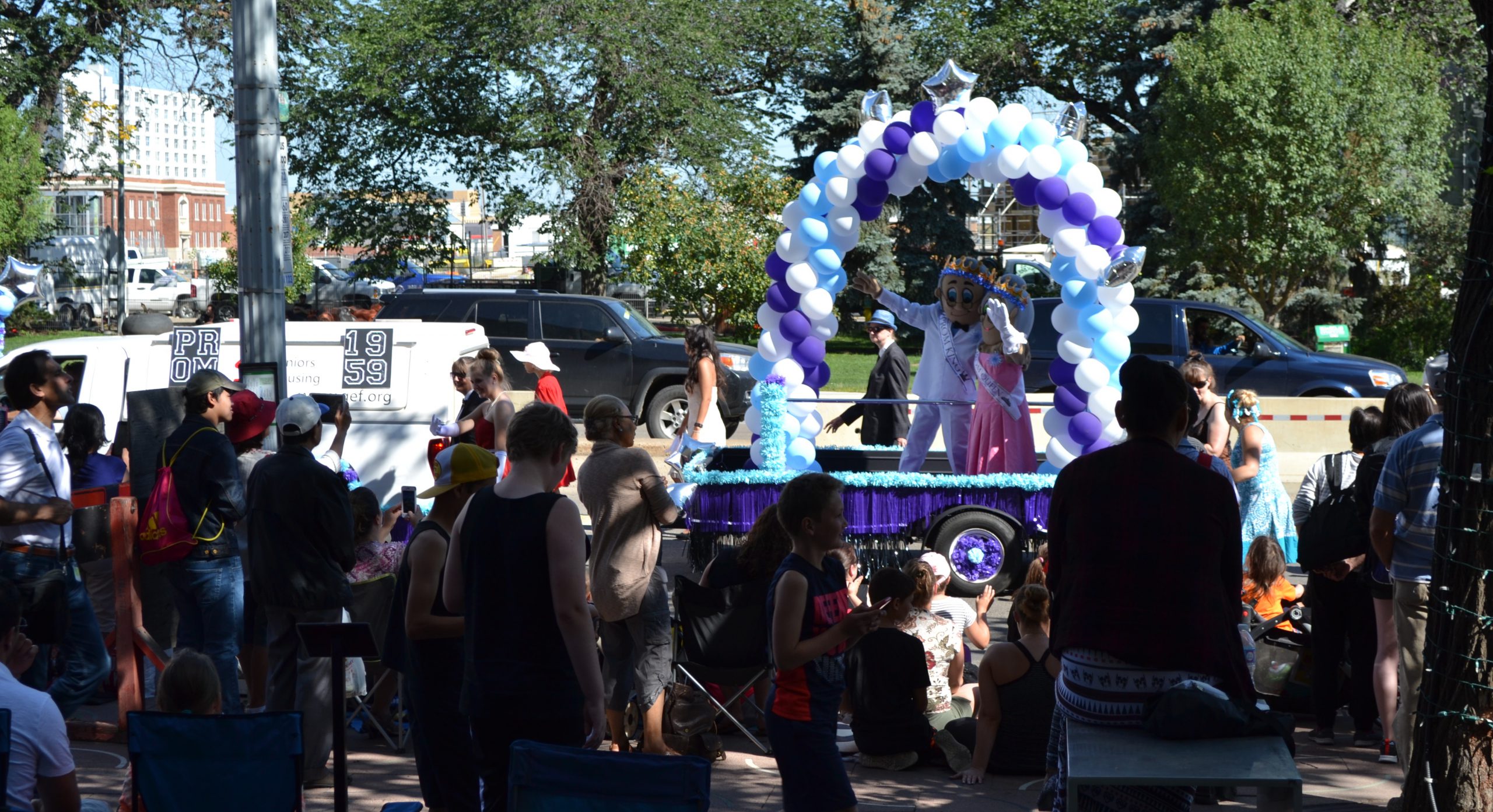
A new bench was placed outside of Cathedral Close on June 29, 2017, and while this isn’t normally something to pay special attention to, this bench represents something more than simply somewhere to stop for a quick rest. As part of the City of Edmonton’s Hello, How Are You? campaign to address urban isolation and mental health, the Buddy Benches were developed by the City Lab as an open invitation to make a connection.
Edmonton Transportation Service (ETS) donated 20 brand new benches to be used as Buddy Benches all over Edmonton as a means to try and address social isolation. The idea is that people can stop and sit on the bench as a signal that they’re looking for someone to talk to. Anyone else can then join the person on the bench, ask how they are, and start a conversation. Most Buddy Benches are painted bright colours with the hashtag #SayHelloYeg to signal that this bench is meant for connections.

“When the bench was being installed, a lot of the tenants were asking what it was about, and after I explained the Buddy Bench program they loved the idea,” says Colleen Simpson, Assistant Manager with Cathedral Close. “We have a couple of our benches and a gazebo on our property, but the Buddy Bench is allowing more connection with the community, which is important for a lot of people.”
Areas being targeted for Buddy Benches include high-density neighbourhoods with lots of pedestrian traffic and close to seniors’ residential buildings. Seniors are increasingly a population at risk for social isolation and more organizations are taking steps to try and address the isolation issues and help prevent any of the adverse health effects that follow social isolation.
“In the short time the Buddy Bench has been in front of Cathedral Close, I’ve already seen a few seniors sit on it, and these are seniors I don’t recognize,” says Simpson. “People from the community are already trying to make more connections and I’m excited to see some of the interactions happen.”

Jim Murland came back to Edmonton in 1948 after serving in the Second World War and he found his first home in the McKernan neighbourhood in the city’s southeast. After he settled in his new home, one of the first jobs he had was adding stucco to the outer brick wall of Knox Metropolitan United Church in the Garneau neighbourhood. Now at 98 years of age, Murland lives at Knox-Met Manor, an apartment building currently being managed by GEF Seniors Housing that was originally built in 1984 in part with help from Knox Metropolitan Church.
The church closed its doors in 2016 with plans to tear down the original building for a new condo development. For Murland, some of his memories of the church that first opened its doors in 1928 stem from one of the most distinctive design features of the building. “I remember attending sermons at the church and always looking up at the stained glass window,” says Murland.
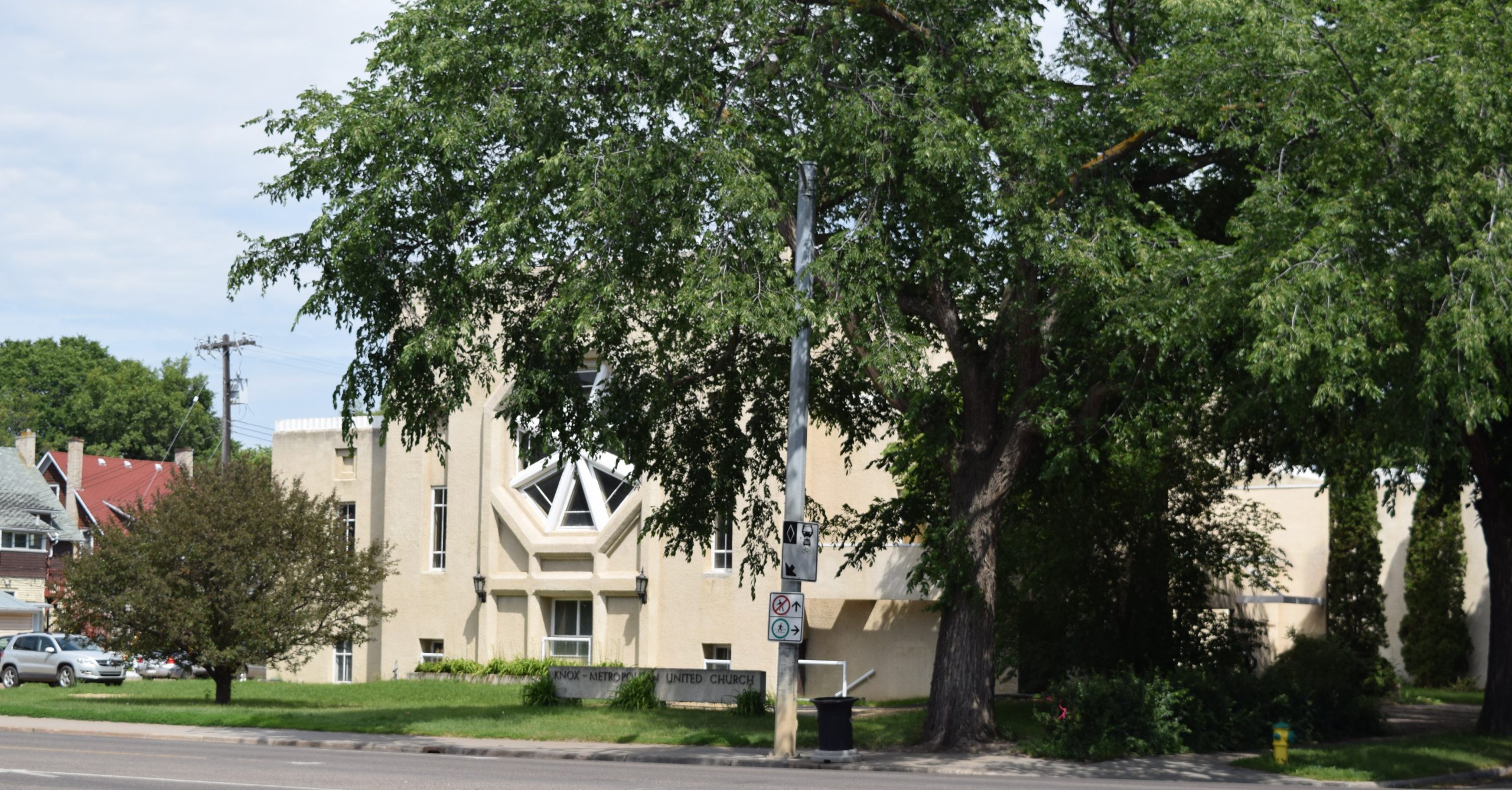
Knox-Met Manor was one of the recipients of a section of the stained glass window because of its close ties to the church. Of the more than 80 tenants living in Knox-Met Manor, many share Murland’s enthusiasm about receiving the window.
Joyce Dahl has been living at Knox-Met Manor since 2000 and was the building’s tenant representative to the church group. She explains that preserving the role that the church played in the development of the property and the connection between the church and the Manor is one to be celebrated. The church played a significant role not just in the history of the Garneau neighbourhood but in Edmonton as a whole.
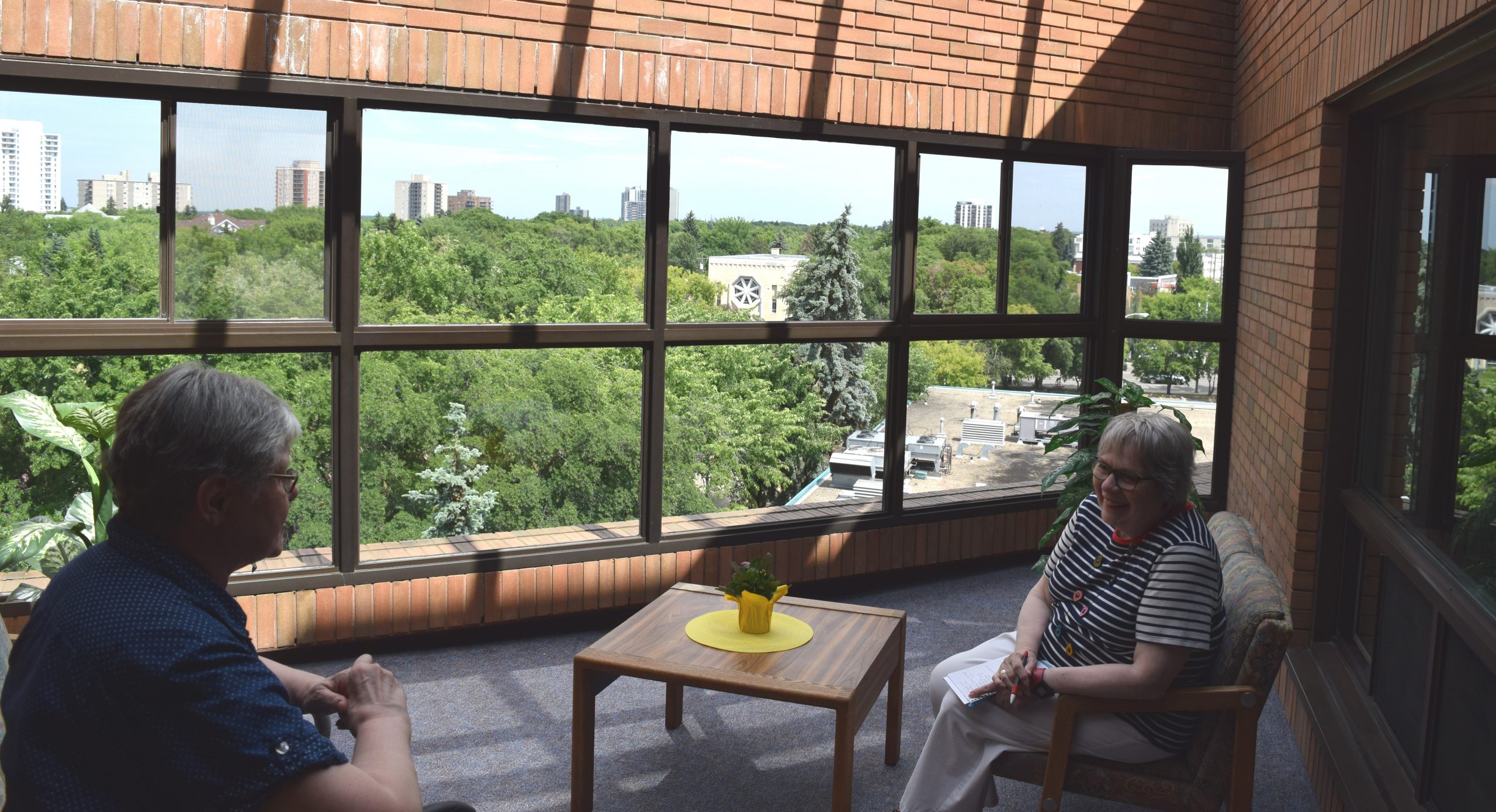
One piece of history is the role Knox Metropolitan United Church played in the Edmonton chapter of Amnesty International. Before she moved into Knox-Met Manor, Florence Miller was a member of Amnesty International and would take the bus from her north-side Edmonton home to the Garneau neighbourhood for meetings. She recollects the different events the Edmonton chapter of Amnesty International played in welcoming new communities to the city from all around the world and the work done to help ensure that these new groups knew they were welcome.
“Even now, there’s still a lot of diversity in [Knox-Met Manor],” Miller says. “We have neighbours from Egypt, Pakistan, South Korea, Papua New Guinea, all over. I want to make sure this piece the church’s stained glass window has a place in our building to commemorate the history of Edmonton being a welcoming city.”
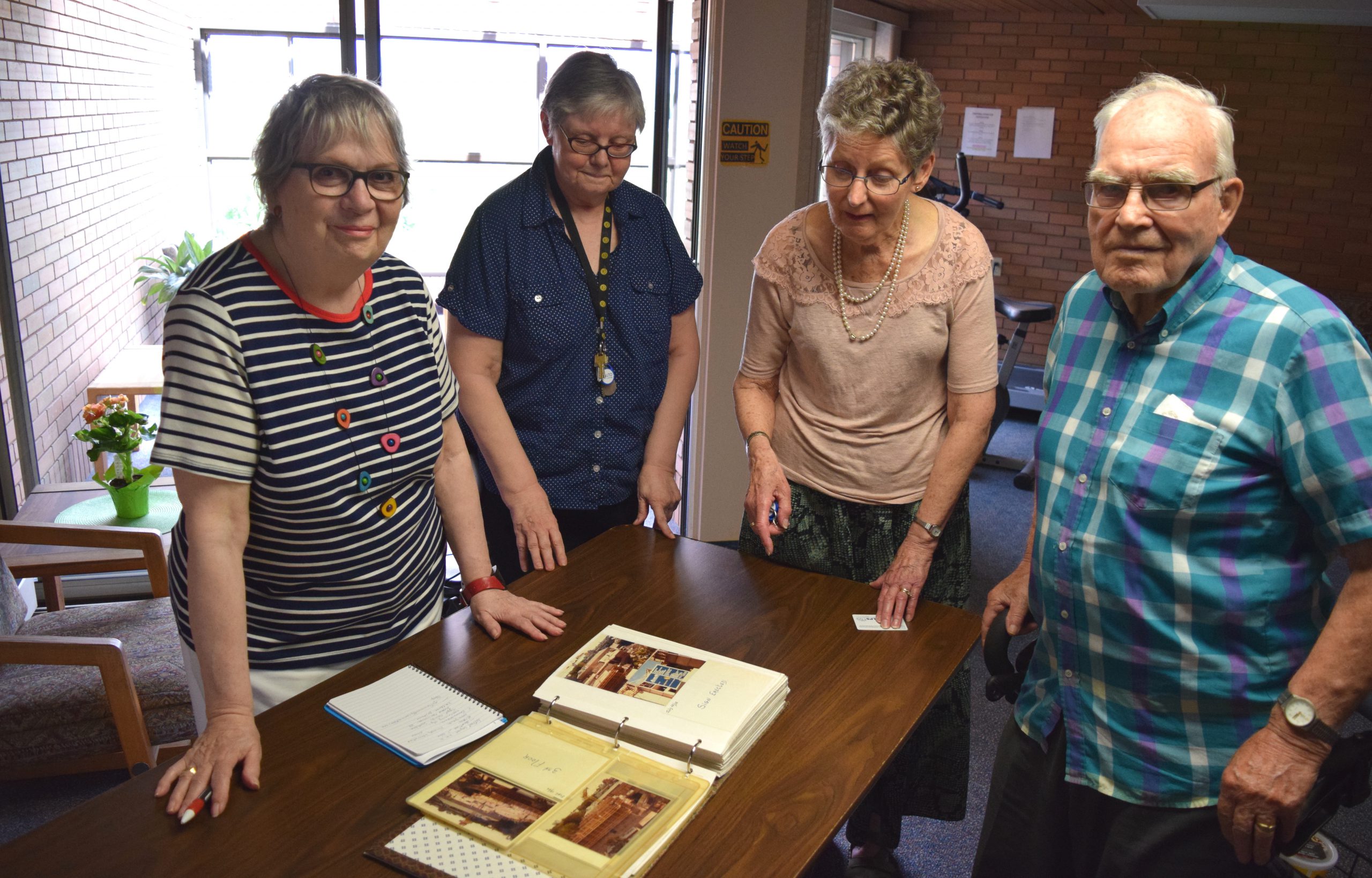
Gail Brown is part of a group of tenants at Knox-Met Manor who want to see the donated piece of stained glass find a permanent place displayed in the building. Though only living in Knox-Met Manor for the past two years and having no direct connection to the church, Brown still feels a responsibility to preserve this piece of the community’s history.
“I’m in very strong support of public art that shows the history of our city,” says Brown. “The church is empty now but it helped build this place that so many people call home. We have a piece of the architecture and it’s something amazing that needs to be respected, preserved and its history maintained.”
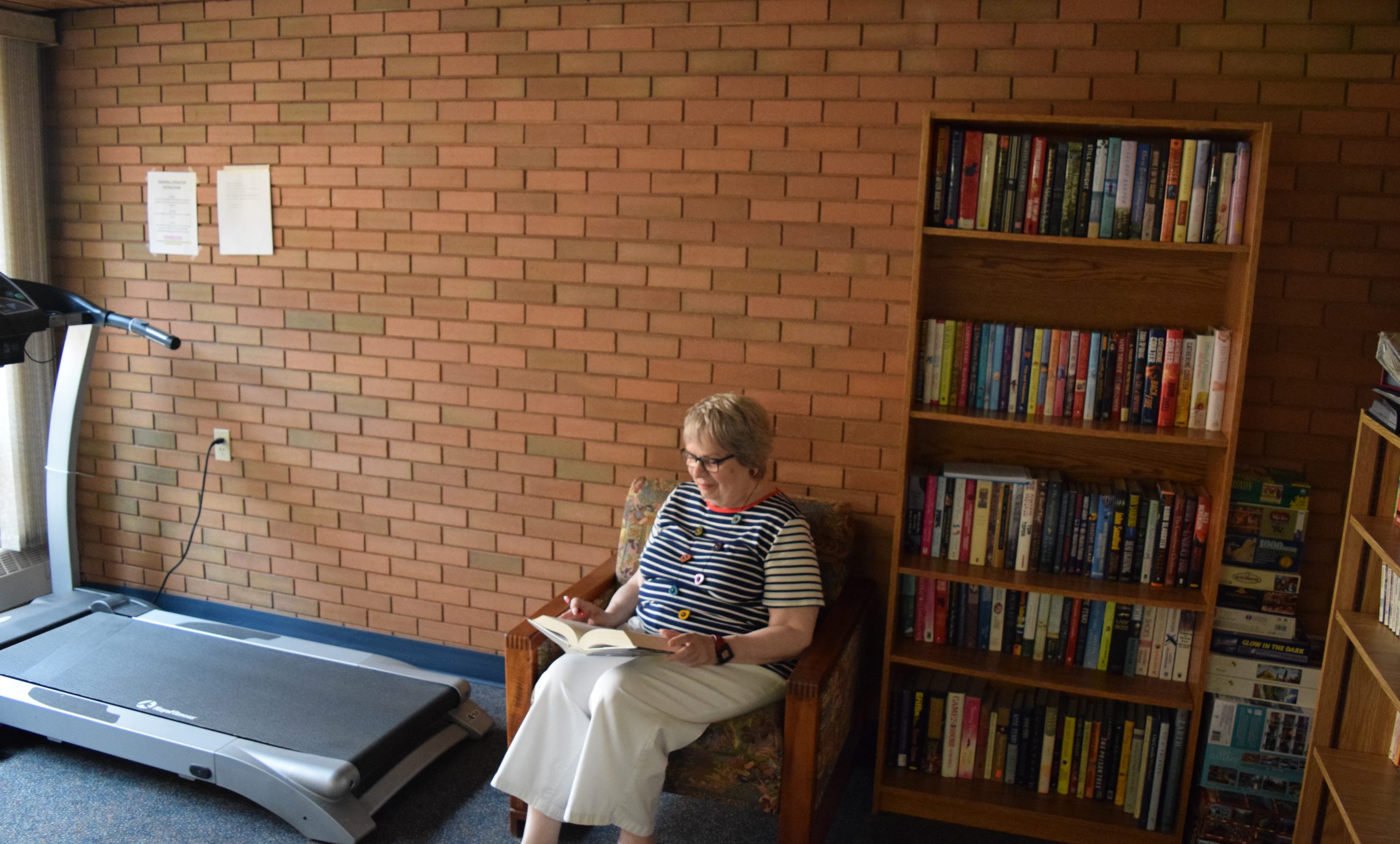
Lorna Etwell points out that the seventh floor of Knox-Met Manor is a perfect spot to mount the stained glass. It’s a shared space where tenants go to do their laundry, read a book, hop on an exercise bike, do a puzzle, or meet in the sunroom that overlooks the Garneau neighbourhood and right to the spot where the empty Knox Metropolitan United Church stands for the time being. She recalled that after some discussion it was determined that the brick wall next to the bookcase was the best location to proudly display the piece of community history.
“It’s an honour to have received this gift from the church,” says Etwell. “We want to do right by making sure it has a place where it can be appreciated.”
